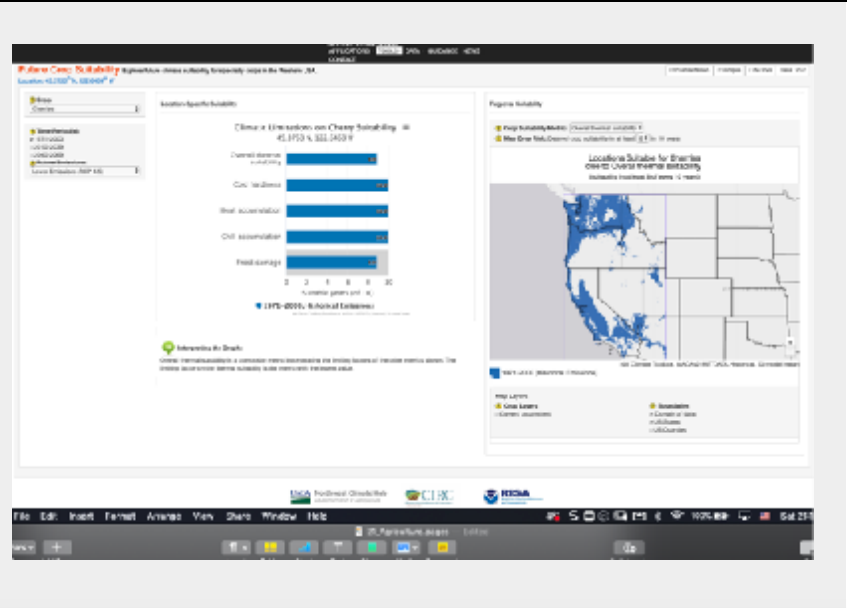20.2: Investigation
- Page ID
- 28661
Activity A – Present Crop Suitability Range
Launch the Crop Suitability Tool in your web browser <https://climatetoolbox.org/tool/Future-Crop-Suitability>. When you do this, you will get a dialog box that will ask you if you want to “Take a tour”, “See an example”, “Set location”, or “Go to tool”. Select the latter. What you will see when you do so should look like Figure 20.2.1.

Crop type is selected from the pull down menu in the upper left the location of areas suitable for growing the crop are shown on the map on the right side of the screen, the time period of the suitability is selected from the pull down menu under the crop selector, and the middle bar chart shows location specific suitability.
Questions - Current crop suitability
- What are crops listed in the crop selector menu?
- Which tend to be southern crops (abundant in southern Oregon and Idaho)?
- Which tend to be northern crops (abundant in northern Washington and Idaho)?
- How does the climate of the southern areas compare to that of the northern?
- Which tend to be coastal crops?
- Which tend to be inland crops?
- How does the climate of coastlines compare with that of the interior?
Activity B – Changing climate and crop suitability in a low emission scenario
To begin this activity reload the Future Crop Sustainability Tool. By default, the selected crop will be almonds. Starting with this crop, answer the following questions.
Questions - Projected crop suitability (low emission scenario)
- During 1971-2000 where were the locations suitable for growing almonds?
- Keeping future emissions at RCP 4.5 where might you find suitable locations for growing almonds during 2010-2039?
- Again, with future emissions at RCP 4.5 where might you find suitable almond locations during 2040-2069?
- Repeat questions 1 through 3 for the other crops in the list?
- What seems to be the trend in the location and size of the range in which these crops can be grown in the late 21st century?
Activity C – Changing climate and crop suitability in a high emission scenario
For this part of the activity begin by selecting almonds as the crop, set the time period to 1971-2000, and select RCP 8.5 from the future emissions menu.
Questions - Projected crop suitability (high emission scenario)
- For emissions of RCP 8.5 where might you find suitable locations for growing almonds during 2040-2069?
- How does this compare to the suitability range for 2040-2069 under the RCP 4.5 scenario?
- Repeat questions 1 and 2 for the other crops in the list.
- Is the trend in the location and size of the range in which these crops can be grown in the late 21st century consistent between the two scenarios?
Activity D – Synthesis
Questions - Synthesis
- What is happening in terms of climate zones for these suitability ranges to migrate as they do?
- Using only suitability range, which crops would seem to do better in a low emission scenario?
- Using only suitability range, which crops would seem to do better in a high emission scenario?
- The Future Crop Suitability tool shows areas that are thermally suitable for raising selected crops. While the suitability range for any of these crops may expand under RCP 4.5 or RCP 8.5 it does not necessarily mean that these crops will expand into new areas. What other factors besides suitability based on temperature might determine whether these crops could be introduced into new areas?


